

How to build your own website / Simple step-by-step guide. In this Covid-scarred age, it doesn’t matter whether you’re a writer or a realtor, you need a website to avoid becoming invisible.
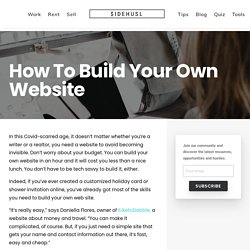
Don’t worry about your budget. You can build your own website in an hour and it will cost you less than a nice lunch. You don’t have to be tech savvy to build it, either. Indeed, if you’ve ever created a customized holiday card or shower invitation online, you’ve already got most of the skills you need to build your own web site. “It’s really easy,” says Daniella Flores, owner of ILiketoDabble, a website about money and travel. Should you build your own website? When do you need your own website?
You may also want to build your own website if you are a freelance author, writer, photographer, or designer. If, however, your business is more of a side hustle than a full-time living, it’s possible to simply create a profile on someone else’s website. These online platforms essentially handle all the technology and marketing. Online Course Development Resources. The resources in this site will walk you through the online course development process drawing on research, best practices, and existing resources from around the web and from the Vanderbilt University Center for Teaching (CFT) and Brightspace Support at the CFT.
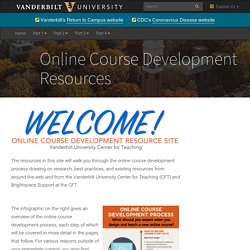
The infographic on the right gives an overview of the online course development process, each step of which will be covered in more detail in the pages that follow. For various reasons outside of your immediate control, you may find yourself on a much more abbreviated timeline or doing the steps of course development in a different order.
You may even be teaching the course as you build it! View of Humanizing Online Teaching to Equitize Higher Education. The Arts, Creativity & Technology 2020: A Guide for Educators & Parents. NOTE TO EDUCATORS | by Mark Gura Creativity, the active ingredient in innovation, is an orientation, a way of responding to the world, a skill set, and importantly, something that individuals can learn and develop.

Even more to the point, it’s something that really must be learned by those who will live and prosper successfully as we move further into the 21st Century. Simply stated, our times have us facing an increased degree of change which is coming at us at a rapidly increasing pace. Along with changes come problems, a high percentage of which now require new responses to surmount them. What sorts of problems? “Very prominent in this body of resources are digital tools that truly support students in developing their creativity.” V&R mapping – Digital. The mapping process is a Visitors and Residents based group activity which is designed to explore individuals engagement with the Web.
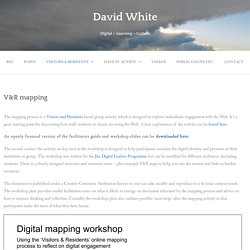
It’s a good starting point for discovering how staff, students or clients are using the Web. A neat explanation of the activity can be found here. An openly licensed version of the facilitators guide and workshop slides can be downloaded here. "Hope is embodied in practice." Kevin Gannon on the @tihighered #podcast about his book Radical Hope. Online Network of Educators sur Twitter : "A little gift from us to you. Here's a playlist of videos to learn how to caption your own YouTube videos using 3 methods: 1) Edit auto-captions, 2) Transcribe, 3) Upload a transcript. #Accessibility #SharingIsCa. View OTC'19 Recorded Session: "California Virtual Campus-OEI: Futures Town Hall". Video stored on #3CMediaSolutions #cccotc19 #techconnect.
We’ve identified five cornerstone attributes of an effective technology coaching program through the Dynamic Learning Project #DLPCoaching. Challenge your friends & family to play a kahoot! □ Go to □ Choose the kahoot you want □ Click “Challenge” instead of “Play” □ Send the game code to your friends □ Let the games begin! "If I want my students to take risks and not be afraid to fail then I need to take risks and not be afraid to fail." - @TheTattooedProf qtd in @SaRoseCav's "How to Make Teaching More Engaging.
Sarah Mojarad sur Twitter : "Here’s a #tweetorial on live-tweeting academic conferences. Thanks for suggesting it @LMSaxhaug! I’m going to describe the poster I presented at the @AmerChemSociety meeting, and I’ll provide some tips on how to effectively us. This is an excellent read as you prepare your spring syllabi. I'm so excited to learn from @vijisathy IRL soon. Stephenie Jordan sur Twitter : "Powering Up Your @CanvasLMS Course: New Year, New You! Lists just make life better. Check off the skills you know and try some new ones this year! #PowerUp #TrainerTips #KISDTechBingo #3eTechAdventur. Fascinating article on the need for slow looking in education. 'The average attention span is 8 seconds'. Recordings from the EDUCAUSE Annual Conference are available! Register to access 45+ sessions from #EDU19. Learn More. EDUCAUSE COVID-19 QuickPoll Results: Help for Students.
During the COVID-19 pandemic, students are facing a variety of challenges in their transition to fully remote access, not only for learning but also for institutional services such as health services, emergency aid, housing and food, and financial services.

As the COVID-19 pandemic upends higher education in 2020, institutions are relying on digital alternatives to missions, activities, and operations. Challenges abound. EDUCAUSE is helping institutional leaders, IT professionals, and other staff address their pressing challenges by sharing existing data and gathering new data from the higher education community.
This report is based on an EDUCAUSE QuickPoll. QuickPolls enable us to rapidly gather, analyze, and share input from our community about specific emerging topics.1 The Challenge. The Key to Ed Tech Success is People, EDUCAUSE Report Says. What do silverware and technology have in common?

Both are pointless without people to use them. If anyone understands this, it’s educators, whose efforts and methods are both increasingly shaped by and shapers of the technologies they use to teach students today. The Difference Between Emergency Remote Teaching and Online Learning. Well-planned online learning experiences are meaningfully different from courses offered online in response to a crisis or disaster.
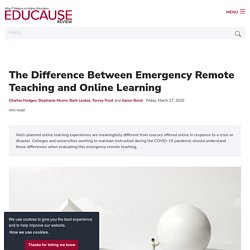
Colleges and universities working to maintain instruction during the COVID-19 pandemic should understand those differences when evaluating this emergency remote teaching. Due to the threat of COVID-19, colleges and universities are facing decisions about how to continue teaching and learning while keeping their faculty, staff, and students safe from a public health emergency that is moving fast and not well understood. A Great Way to Quickly Turn Notes and Webpages Into Review Activities. Tips to Deter Zoom-bombers (general audience) Live Online Attendance Tracking. Edtechessentials2. Tools for Social Annotation in the Digital Age. The other day I pulled out an old family cookbook and discovered several handwritten sticky notes scattered in the margins.
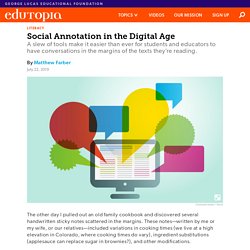
These notes—written by me or my wife, or our relatives—included variations in cooking times (we live at a high elevation in Colorado, where cooking times do vary), ingredient substitutions (applesauce can replace sugar in brownies?) , and other modifications. Family cookbooks are an example of social annotation, a practice of collaborative notetaking that feels tailor-made for digital spaces even though it’s quite old. I recently spoke with Jeremiah (Remi) Kalir, an assistant professor at the University of Colorado, Denver, about digital and web annotation. Kalir coauthored an upcoming book on this topic called Annotation with Antero Garcia, an assistant professor at Stanford University. @arthistory4all. How I Use Evernote to Organize my Secondary Source Research. Karl Dahlfred | When it comes to masters and doctoral work, the key to a successful thesis or dissertation is organizing your data.

It is great that you are learning all sorts of relevant and interesting information, but will you be able to find it again when it comes time to write? There are lots of different software options out there, such as Zotero, OneNote, and Endnote, but for my doctoral research I’ve put all my eggs in the Evernote basket. Hypothesis – The Internet, peer reviewed. DETCHE 2018 Student Panel Intro - Google Slides. 3 Ways to Enhance Your Online Instruction - ACUE Community. Tips & Tricks Archives - Ecampus Course Development and Training. “…expertise is learned from prolonged experience with good feedback on mistakes.” – Daniel Kahneman Students are eager to receive meaningful feedback quickly.
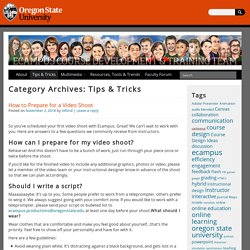
With hopes of improving their class performance, timely and substantive feedback is essential to helping students get on track before it is too late. Yet, knowing this doesn’t change why feedback and grading sometimes gets put off, despite our best intentions – it can appear daunting and time consuming. Self-checks Not all feedback requires your intervention or even a grade. Screencasts As a student, I really enjoyed a course where the faculty member used screencasts to give feedback. Docs vous permet de créer et de modifier des documents en ligne gratuitement. Tout Google avec un seul compte Connectez-vous pour accéder à Google Docs. Why Ceramic Artists Are So Good at Dealing with Failure.
Wedel acknowledges that those who are proficient in clay tend to develop a careful process with a fixed number of variables, thus eliminating the chance for failures. But as soon as an artist wants to try something new or experiment, that’s all thrown out the window. “Clay is not forgiving to the individual who is always moving forward,” he offers. To grow and develop new work, artists must face brushes with failure. He recalls a surprisingly liberating four-month period where he was making large porcelain sculptures that consistently failed. “They would slump over, explode, and crack,” he says. Create Tutorials that Simplify Any Software and Website - WalkMe™ - Digital Adoption Platform. Tools and Tool Hacking DPL 2018. Online Education Initiative -
Teaching in the Era of Bots: Students Need Humans Now More Than Ever. Interested in Teaching Online. Using a Course Start-Up Message to Improve Student Outcomes. Giving students a list of tips for online learning helped them better prepare for and succeed in their courses. In 2013, Plymouth State University (PSU) formed an Online Reflective Practice Group to explore how higher education faculty might better cultivate student success in online course environments. Our group consists of instructors in New Hampshire who primarily teach online courses, teach some online courses, or want to transition to online teaching environments.
In our early virtual meetings, which were held monthly, we shared practices and experiences. Soon, however, we found a common theme emerging: Our students, most of whom were 25 or older and thus considered adult learners,1 were seemingly unprepared for online learning. To better support each other and meet our students' learning needs, we decided to further investigate what "adult learner" actually means and what knowledge, skills, and attitudes would help all students meet the learning requirements of online courses. Research: Online Courses Associated with Improved Retention, Access. Online Ed Research: Online Courses Associated with Improved Retention, Access Online courses are associated with higher retention and graduation rates, increased access and cost savings of as much as 50 percent, according to a new study from Arizona State University.
The research is built on case studies from a half-dozen institutions "with a strong track record of using digital learning to improve student outcomes," according to information released by ASU. In addition to ASU, the other schools examined for the study include Georgia State University, Houston Community College, Kentucky Community and Technical College System, Rio Salado Community College and University of Central Florida. Key findings of the report include: The full report is available at edplus.asu.edu. About the Author Joshua Bolkan is contributing editor for Campus Technology, THE Journal and STEAM Universe. 20 Facts About the Impact of E-Learning [#Infographic] Timetoast timeline maker. Make a timeline, tell a story.
Turning Your Students Into Web Detectives. Canvas by Instructure. Audio Conferences & Webinars. TAA webinars are one-hour live, interactive sessions that connect you to experts discussing a variety of topics designed especially for textbook and academic authors. Members can also access 100+ presentations on demand. How to register for an upcoming webinar: Members: You can participate in as many sessions as you'd like for free. To sign up, click the Register button below. Read Frequently Asked Questions About TAA Webinars. Quiz - Quizizz. Edutopia. Patricia Chen, a postdoctoral researcher at Stanford and the lead author of the study, says she often had students coming to her lamenting their poor test scores.
Collaboration and Discussion Tools Help Make Online Courses More Social. Tips to Help Students Make the Most of Feedback - Online Network of Educators. 2015_9_HE_Infographic_LMS_Course_Design_US_Canvas - HE-Infographic-Course-Design.pdf. PRESS RELEASE FALL 2017 - Teaching Online Pedagogical Repository. Readiness - Online Education Initiative. New Project Explores Higher-Education Podcasts (And Their Impact) These days busy college leaders hone their craft while walking the dog or commuting to campus (with earbuds in), thanks to the recent explosion of podcasts about higher education. How Faculty Teaching Load, Employment Status Effect Student Performance. Some years ago, Witt Salley, EdD, director of online education at Clemson University, was working for a community college in Missouri.
2017 nmc strategic brief digital literacy in higher education II. Universities Use Analytics, Authentication to Prevent Cheating in Online Courses. In college classrooms, detecting cheating can sometimes be as simple as catching a student looking at someone else’s exam. But for online educators, who may have students in various corners of the country, catching cheating on an exam, assignment or essay is a lot more difficult. Thanks to digital tools with elements of analytics and online proctoring, universities can keep cheating at bay. Technology Use Boosts Students’ Confidence in Their Job Prospects [#Infographic] Landing that first post-grad job may be difficult, but many college seniors think they’ve got the digital skills employers want, thanks to their time on campus.
Online Students Need More Interaction with Peers and Teachers [#Infographic] Open Version! – Best Practices for Teaching with Emerging Technologies. Using VoiceThread to Create Community in Online Learning. Da Button Factory: website button maker. GOTS-OTC. Humanizing Online Learning – Teaching and Learning Innovations at CI. Untethering - NMC 2017 - Google Slides. Embedding a YouTube Player with Responsive Aspe... How to Blur Faces & Objects in YouTube Videos. VC Home – ANTH 101. CI Learn 2.0 - Getting Started - Academic Technology Services (ATS) - CSU Channel Islands. Using VoiceThread to Create Community in Online Learning.
Amazon. Digital Courseware Instructional Practice. QCTIP. Digital Aponte – Writing, Painting, and Making Freedom in the African Diaspora. Who Is the Average Online College Student? [#Infographic]